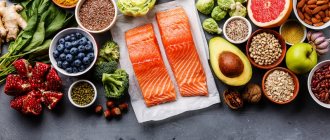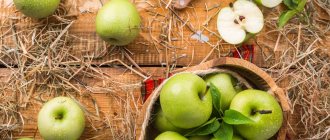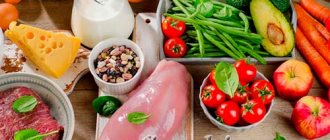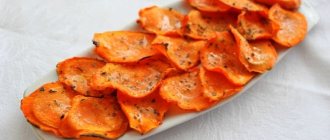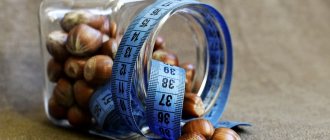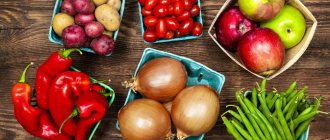On a gentle diet, there is no painful feeling of hunger, the body receives all the necessary nutrients, and the kilograms are easily lost. Choose one of 14 effective diets and remove excess fat from your waist and hips!
Author: Kristina Lobanovskaya, doctor, practicing nutritionist Article updated: 11/10/2020
Most weight loss diets are based on fairly strict restrictions. Compliance with them is associated with a feeling of hunger, against the background of which the so-called “dietary depression” develops. Along with rapid weight loss, the body suffers a powerful blow due to a deficiency of nutrients. As a result, internal organs cease to fully perform their functions, which leads to the development of a number of diseases. Beneficial programs are not so radical. They are aimed at gradual weight loss without negative effects on health.
Advantages
A gentle diet is a diet enriched with minerals and vitamins for relatively quick weight loss. With its help, it is possible to remove waste and toxins from the body that have accumulated for many years. The term “gentle diet” was first introduced into the lexicon by the Soviet therapist M.I. Pevzner, who is considered to be the founder of dietetics as a science.
Gentle nutrition systems for weight loss are unique in that they help the body get rid of extra pounds without forcing the body to go to extremes and starve.
A “soft” diet has many advantages:
- Cleanses the body of harmful accumulations.
- Consists of simple and affordable dishes.
- Does not provide for strict prohibitions.
- Does not put a strain on the digestive system.
- Provides a person with energy.
- Helps maintain weight in the long term.
The main advantage of a gentle nutrition program is the chance to switch to correct eating habits without much difficulty.
The daily energy value of such a diet is about 2250 kcal. Approximately 250 grams are allocated for carbohydrates, 90 grams for fats, and 85 grams per day for proteins.
Rules
- Fractional meals. Food is taken little by little, 5-6 times a day.
- Drinking regime. Water in the amount of 1-1.5 liters is consumed between meals. You can't drink while eating!
- Healthy dishes. Products are prepared in the correct ways: stewing, boiling, baking, steaming.
- Food should be at room temperature.
- Refusal of spices. A little salt is allowed. Lemon juice, parsley and dill are used to improve the taste of dishes.
- Last meal 3 hours before bedtime.
When creating a diet menu, it is important to follow certain rules:
- Include protein in your diet, which maintains metabolic processes at the proper level and accelerates fat burning.
- Eat foods rich in iron.
- Don't give up complex carbohydrates.
- Regularly take vegetable oils that cleanse toxins (flaxseed, grape seed, olive, sesame).
The following products are prohibited:
- semi-finished products and sausages;
- smoked meats and canned food;
- rich pastries and fresh bread;
- fatty dairy and fermented milk products;
- coarse porridges (barley, pearl barley, millet);
- vermicelli;
- spinach and sorrel;
- radish and radish;
- chocolate and ice cream;
- pickled vegetables;
- fruits that are too sour;
- berries with hard grains;
- carbonated drinks and alcohol.
Recommended for use:
- dry biscuits, whole grain and rye bread;
- lean beef, chicken, turkey, rabbit;
- beef liver, tongue;
- eggs;
- lean fish;
- low-fat dairy and fermented milk products;
- hard mild cheese;
- green and herbal tea.
Recommendations for Beginners
A gentle nutritional system for weight loss is especially recommended for those who have ventured into dietary restrictions for the first time. This is a good start for further weight loss through more rigorous programs.
Before starting a diet, you should go through a preparatory stage, which consists of restoring water balance. You should drink at least two liters of water per day. The first glass is in the morning on an empty stomach, the rest – half an hour before meals.
To make your first experience successful, it is recommended to follow the rules of healthy weight loss:
- The diet should be enriched with the components necessary for the normal functioning of the body: microelements, proteins, carbohydrates, fats and vitamins.
- It is very important to control the caloric content of food: calorie intake should not exceed their expenditure.
- Dishes should be prepared with minimal loss of macro- and microelements.
Beginners should not follow a “soft” diet for more than a week and repeat the course in less than a month.
Packaged juices and alcohol, fatty and salty foods, various sauces and mayonnaise are completely excluded from the diet. It is recommended to replace sweets with a spoonful of fresh honey or dried fruits. Occasionally you can indulge in a piece of dark chocolate. Confectionery products are perfectly replaced with curd desserts. For greater benefits, you can add dried apricots or carrots. Sausages are strictly prohibited.
Natural coffee is allowed at the very beginning of acquaintance with a light diet, but only empty coffee - without milk, cream and sugar.
The nutrition system menu for beginners could be like this:
- Breakfast: buckwheat porridge with water, rye bread toast with a piece of low-fat cheese, unsweetened green tea.
- Snack: fresh apple.
- Lunch: light soup, a piece of boiled beef, cucumber salad with herbs.
- Afternoon snack: orange.
- Dinner: casserole of low-fat grainy cottage cheese, herbal decoction.
Taking a vitamin-mineral complex will help support the body, which is faced with an unusual way of eating.
Basic principles of diet for the rehabilitation period after intestinal operations
The main key to successful recovery after surgery on the digestive organs is diet. A properly selected diet contributes to the speedy restoration of digestion and accelerates tissue regeneration by reducing the load on the intestines. The diet relieves the painful symptoms of flatulence and pain along the intestines, normalizes stool and peristalsis.
General features of the postoperative diet
The menu is selected by the patient himself, the doctor only advises and recommends certain food products for consumption. The diet should be followed both in the hospital and after discharge for 1-2 months until peristalsis is completely restored. It is necessary to return to your usual diet gradually, without sudden transitions.
Basic principles of postoperative diet:
- Hunger during the first and second days after surgery. Parenteral nutrition (intravenous administration of glucose and protein solutions).
- Extremely gentle food for 1-2 weeks after surgery, when the patient is still in the hospital: porridge, pureed soups, pureed vegetable and fruit purees, compotes, fruit drinks and teas.
- After discharge from the hospital, prepare food yourself by steaming or boiling it in salted water, followed by grinding it into a paste-like consistency.
- Compliance with the diet for another 1 month after discharge.
- Exclusion of fatty, salty, smoked, fried and irritating foods, as well as spicy, hot, bitter and sour.
- Avoiding sweet foods and foods that cause increased gas formation and bloating.
- Eating at the same time of day.
- At least 5-6 meals per day.
- All dishes are served warm.
The main principle of the diet is to restore normal stools, normalize peristalsis and relieve painful symptoms. This makes the patient’s condition easier after surgery and relieves stress on the digestive tract. As a result, tissue regeneration proceeds faster, and the recovery period does not take so much time.
What foods can you eat after surgery?
Products that do not irritate the intestines, are easily digestible and digestible are recommended for consumption. It is better if they undergo heat treatment before use.
After surgery, the following are allowed for use:
- Boiled cereals and grain products.
- Boiled vegetables in the form of puree.
- Boiled and baked fruits in the form of puree.
- Fermented milk products.
- Meat broths without adding spices.
- Meat purees (at 1-2 weeks), then pieces of lean meat.
- Dried black bread and crackers.
- Berry jellies, jelly.
- Boiled and soft-boiled eggs.
- Mineral water.
- Vegetable juice.
- Black or green tea.
- Fruit drinks, compotes, decoctions.
What foods should you not eat after surgery?
Irritating (spicy, bitter, sour, sweet) and hot foods should not be eaten after surgery. Products that cause increased gas formation and fermentation, as well as difficult to digest foods, are excluded from the diet.
After surgery, the following are prohibited for use:
- Sour fruits and berries.
- Preparations for the winter - pickles, smoked meats, marinades.
- Canned food.
- Sweets – candies, cookies, chocolate, etc.
- Mushrooms.
- White and fresh bread, baked goods.
- Nuts.
- Cold drinks.
- Legumes.
- Alcohol.
Important! It is recommended to avoid these foods for at least three weeks after surgery. It is advisable to maintain such a diet for 2 months.
Features of the diet after intestinal surgery for cancer patients
Nutrition alone cannot defeat cancer. The diet is prescribed after surgery, when part of the intestine has already been removed. The menu is selected in such a way as to normalize the patient's stool, while the energy value of the dishes must fully satisfy the needs of the patients.
The menu includes large quantities of fruits and vegetables, broths, and cereal porridges. Meat consumption is limited (no more than 100 g per day of lean meat). The main source of protein is seafood, which is digested more quickly and contains a lot of microelements.
Food is served warm. Every day they monitor the nature of the stool and the amount of liquid drunk (at least 2-2.5 liters per day).
Diet after surgery for intestinal adhesions
Adhesive obstruction is a very common disease of the digestive tract. After surgery for intestinal adhesions, the patient must follow a special diet.
The menu includes exclusively mushy and puree-like foods. All products are grated and ground in a blender to puree. It is not recommended to eat rough food for 1-2 weeks after surgery.
At this time, you need to drink a lot of liquid: teas, rosehip or herbal decoctions, compotes, fruit drinks. The menu includes jelly and berry jellies as dessert. During the diet, stool passage is also monitored. There should be at least 6-8 meals in small portions per day.
Features of the diet after surgery for intestinal obstruction
If there is an intestinal obstruction, a large portion of the small intestine is removed. This is dangerous by the development of malabsorption syndrome with subsequent transition to asthenic syndrome. Therefore, such patients must follow the diet for life.
The menu includes easily digestible foods; difficult to digest foods are excluded, since they do not have time to be digested by the intestines. Vegetables, broths and soups, cereals and purees are allowed in large quantities. The patient needs to independently monitor the condition of the stool and the characteristics of the body’s reaction to certain foods, since the digestibility of food varies from person to person.
Diet after intestinal stoma surgery
A stoma is the removal of the blind end of the intestine to the anterior surface of the abdominal wall. This is necessary in the first months after surgery for intestinal cancer or intestinal obstruction. In a word, any operation for bowel resection, as a rule, ends with the imposition of a stoma.
This is a temporary measure, however, the stoma causes a lot of inconvenience to the patient. You can learn to live with an open intestinal stoma if you follow the basic principles of nutrition.
The menu is mainly aimed at facilitating the act of defecation, while the patient should not have loose or overly hard stools. The patient is recommended to keep a food diary, where he writes down everything he ate the day before and the digestive reaction to the food eaten. Indicate symptoms (flatulence, pain, cramps), the nature of the stool (liquid, hard, mushy) and the amount of food eaten.
Important! Nutrition for intestinal stoma includes a variety of vegetables, fruits, soups, dairy products, and meat. By keeping a food diary, the patient himself adjusts the diet, depending on the body’s response to the dish. For constipation, the menu includes beets, prunes, and plums. For diarrhea - grain porridge.
A gentle version of the Dukan technique
The system of the French nutritionist Dukan is considered one of the most effective for safe weight loss. Its lightweight version, called the “Nutrition Ladder,” is an idea for those who cannot handle the classic program with all its restrictions and rules. The diet is balanced.
It’s not for nothing that the method is called a “ladder”: a week on it is divided into 7 steps, each of which means 1 day. Every day the range of products approved for consumption is expanding. Dukan recommends sticking to the system until the optimal body weight figure is finally achieved.
Required conditions:
- 1.5-2 liters of water per day.
- Consumption of oat bran in the amount of 1.5-2 tablespoons.
- Walking for 30 minutes.
Meals by day:
- 1st – protein. It is allowed to eat fish, lean meat, low-fat dairy products, and eggs.
- 2nd – proteins + vegetables. Starches and legumes are prohibited.
- 3rd – proteins + vegetables + fruits. Grapes and bananas are prohibited.
- 4th – proteins + vegetables + fruits + whole grain bread (a couple of pieces per day).
- 5th – several slices of cheese are added to the diet.
- 6th – the diet may include starchy foods: rice, pasta, potatoes in an amount of 200 grams.
- 7th – food can be varied, tailored to your own preferences. It is acceptable to drink a glass of dry red wine and eat a full meal of several courses.
Weight loss with simple nutrition is about 1 kilogram per week. Losing weight looks comfortable, so the technique is suitable for nursing women, teenagers and older people.
The correct way out of the diet involves gradually eliminating days with the most limited diet. This same moment acts as a reinforcement, preventing the lost weight from returning again. During the first week, after the end of the event, the protein-vegetable day should be excluded.
Read more: Dukan Diet
Advantages and disadvantages
| pros | Minuses |
|
|
Modes for fast weight loss
The gentle diets presented below are suitable even for beginners.
Fractional
The most gentle way for the body is weight loss based on the principles of fractional nutrition. Food should be taken often, but little by little. This will avoid even a hint of hunger. The diet can last from 5 to 10 days. At this time, it is important to completely eliminate flour, sweets and alcohol.
An approximate diet is:
- 8:00 – herbal decoction without sugar (in the first two days you can add a little fresh honey).
- 10:00 – carrot-apple salad with lemon juice.
- 12:00 – plum or peach.
- 14:00 – a portion of boiled fish, a slice of rye bread.
- 16:00 – a piece of low-fat cheese.
- 18:00 – salad of boiled carrots and beets with a small amount of flaxseed oil.
- 20:00 – 8 pieces of dried apricots.
- 22:00 – a glass of skim milk or kefir.
You are allowed to drink plain water during the day. Several times a day you can use rosehip decoction (if there are no problems with the kidneys).
Read more: Fractional diet
Hypocarb
The success of a no-carb diet for weight loss is based on consuming only fats and proteins. Following the program is not difficult, but the body is still harmed. A gentle version of the system, defined as hypocarbohydrate, does not imply the complete elimination of carbohydrates, but a reduction in the volume of their intake to a minimum.
Allowed for use:
- dairy products;
- porridge;
- fruits;
- vegetables;
- chicken meat without skin.
Among the especially recommended vegetables are eggplants, cabbage, and cucumbers. As for fruits, it is advisable to eat kiwi, plums, peaches, apples and citrus fruits.
You will have to eat in small portions. All products containing flour should be removed from the diet:
- bread;
- buns;
- pasta;
- cookie.
You need to drink at least 1.5 liters of water per day. Before 12 noon you are allowed to eat a slice of dark chocolate.
Important! It is not recommended to “sit” on a hypocarbohydrate diet for more than seven days; it can harm the liver and kidneys.
Sample menu for one day:
- Breakfast: low-fat cottage cheese with the addition of sour cream and dried fruits (dried apricots, raisins, prunes), tea or coffee.
- Lunch: a piece of dark chocolate or a dessert spoon of fresh honey.
- Lunch: vegetable soup, lean porridge, vegetable salad with vegetable oil.
- Afternoon snack: muesli with milk, apple.
- Dinner: vegetable stew, a piece of boiled chicken, tea.
Vitamin and protein
A nutrition system based on the consumption of protein foods is popular all over the world. Its essence is to exclude fats and carbohydrates from the menu. A diet can be an unbearable burden for an organism unprepared for such tests. In this case, it makes sense to stick to its lighter version - a tasty and healthy vitamin and protein one.
A gentle vitamin-protein diet is an effective way to get rid of fat deposits and increase body elasticity.
Throughout the course, the menu is shown to include only those products that contain vitamins and protein. The approximate menu for day 1 is as follows:
- Breakfast: unsweetened coffee or herbal infusion, orange.
- Lunch: a couple of slices of hard cheese, fruit and vegetable juice.
- Lunch: a portion of boiled chicken breast, boiled egg, tea.
- Afternoon snack: unsweetened tea with crackers, apple.
- Dinner: vegetable salad with vegetable oil and quail egg, boiled meat, kiwi.
- Before bed: herbal tea.
On salads
Salad diets are considered one of the most budget-friendly and have a positive effect on the condition of the entire body. This is due to the high content of vegetables and herbs in the diet, rich in vitamins, fiber and minerals. Mono diets on salads last three days, while you can stick to softer ones for much longer.
In addition to salads, the menu contains protein products. In a week you can lose up to 5 kg of weight.
Menu for the week (standard salad serving size is 200 grams):
- Monday – “Whirl” salad (5 servings), 400 ml of kefir, a glass of tomato juice.
Preparing the salad: chop 300 g of white cabbage, grate 300 g of beets and 200 g of carrots, chop 50 g of greens. Mix, add a little vegetable oil and lemon juice.
- Tuesday – Greek salad (5 servings), 300 g of boiled chicken without fat, 400 ml of kefir, 200 ml of tomato juice.
Preparation: 350 g of cucumbers and tomatoes, chop 200 g of cheese into cubes, cut 250 g of bell pepper into strips, cut 1 head of Yalta onion into half rings, chop the parsley. Mix the ingredients, add the olives cut into rings. Pour in vegetable oil and pepper.
- Wednesday – “Fat Burning” salad (4 servings of 300 grams), 2 boiled eggs, 500 ml of kefir.
Preparation: chop 300 g of parsnips and celery root into strips, cut 200 g of bell pepper and cucumber into slices, chop 50 g of green onion and parsley. Mix, season with low-fat yogurt.
- Thursday – Green salad (4 servings), 1 boiled egg, 70 grams of seafood, 400 ml of tomato juice.
Preparation: finely chop 400 g of lettuce, chop 200 g of tomatoes and cucumbers coarsely, cut 200 g of bell pepper into strips, finely chop parsley, green onions and dill. Mix, sprinkle with olive oil and lemon juice.
- Friday – Tuesday menu. Fish is used instead of chicken.
- Saturday – Monday menu.
- Sunday – Wednesday menu + 200 grams of buckwheat.
Low calorie recipes
Let's look at several options for delicious dietary dishes that can easily be included in your diet:
| Name | K/B/F/U per 100 grams | What will you need? | Preparation |
| Curd casserole on rye flour with dried fruits | 151/17,3/2,1/15,2 |
|
|
| Funchoza (Japanese green bean noodles) with vegetables and chicken | 115/6,6/1,7/19,8 |
|
|
| Seafood salad | 74/4,6/5/2,7 |
| Mix all the ingredients, season with lemon juice and oil - the salad is ready. |
Don't be afraid to experiment. You can independently prepare alternatives to your favorite dishes, but with fewer calories, replacing harmful foods with healthy and permitted ones. This way the food will be as tasty and healthy as possible.
“Soft” options for mono-diets
Buckwheat, kefir and rice diets top the TOP of effective mono-diet for weight loss. They are distinguished by their rigidity and short duration (no more than 3 days). Gentle versions of such diets are easier to tolerate: in addition to the main product, additional dishes and drinks are allowed into the diet. You can “sit” on them for 7 days, and if necessary, repeat after 1-1.5 months.
Buckwheat
The buckwheat porridge diet remains one of the most effective for weight loss. It is recommended by nutritionists as the safest way to lose weight. Buckwheat has long been called a healing product that saturates the body with useful substances and energy.
A gentle version of the buckwheat system is designed for a week. The main rule is the ban on eating fatty meat. You need to prepare the porridge in a special way - not boil it, but steam it. To do this, pour boiling water over buckwheat in a ratio of 1:1.5 and let stand for 2-3 minutes. Afterwards, drain the water and pour boiling water over the porridge again. They let it brew overnight and start using it the next morning.
A sample menu for one day looks like this:
- Breakfast: a portion of buckwheat porridge, 120 grams of low-fat cottage cheese, a glass of yogurt, a slice of hard cheese, tea.
- Lunch: green vegetable salad, a piece of boiled veal, mineral water.
- Afternoon snack: a portion of low-fat cottage cheese, a green apple.
- Dinner: buckwheat and vegetables with soy sauce, herbal decoction.
The diet allows you to lose weight without feeling an acute feeling of hunger, saturates the body with vitamins and protein. After which the achieved weight will be maintained.
Buckwheat and kefir
A simpler version of a gentle buckwheat diet involves introducing kefir into the diet. The program is designed for a week. The first four days are considered limited in the amount of food consumed.
1-4 days
- Breakfast: a portion of buckwheat, a glass of low-fat kefir.
- Lunch: a glass of fermented milk drink.
- Lunch: a portion of buckwheat porridge, low-fat yogurt.
- Dinner: a portion of porridge, a glass of kefir.
5-6 days
- Breakfast: a portion of buckwheat, green tea without sugar, crackers.
- Lunch: an apple or half an orange, low-fat yogurt.
- Lunch: a portion of buckwheat porridge, a tomato, a glass of fermented milk drink.
- Snack: vegetable salad.
- Dinner: a portion of buckwheat, a glass of fermented milk drink.
The seventh day diet consists only of porridge (200 g) and 1% fat kefir (1 liter), which are divided into 4 doses. In addition, per day you need to drink at least 2 liters of purified water, to which you can sometimes add a spoonful of fresh honey or a slice of lemon.
Read more: Buckwheat diet
Kefir
A healthy fermented milk product is actively used in almost all nutrition systems for weight loss. Kefir normalizes the functioning of the nervous and cardiovascular systems, helps improve intestinal functionality, and is indispensable for respiratory diseases.
The benefits of kefir for weight loss are obvious:
- low calorie;
- contains beneficial bacteria;
- rich in protein.
Can kefir be considered the main product during gentle unloading? Undoubtedly. This lasts 7 days. You will eat according to this scheme (all foods are divided into equal quantities and consumed 4 times):
- Monday: 1.5 liters of low-fat kefir, five boiled potatoes in their jackets.
- Tuesday: 1.5 liters of low-fat fermented milk drink, a portion of boiled chicken, tomato.
- Wednesday: 1.5 liters of low-fat fermented milk product, a portion of boiled veal.
- Thursday: 1.5 liters of low-fat fermented milk product, 150 grams of stewed fish, vegetables.
- Friday: 1.5 liters of kefir, fruits and vegetables.
- Saturday: 2 liters of kefir, dried fruits.
- Sunday: fasting day on still mineral water.
While observing gentle unloading on kefir, it is advisable to use a vitamin-mineral complex.
Read more: Kefir diet
Rice
The staple of Asian cuisine is often used in domestic diets for weight loss. Rice is good for the gastrointestinal tract and gives a feeling of fullness. To achieve weight loss effects, it is recommended to choose brown rice. It is considered the most useful because it quickly removes toxins and normalizes the functioning of the digestive system. If you can’t find such rice, you can choose long-grain white rice.
Unlike the strict rice mono-diet, the gentle one allows you to include other products in the menu: dairy, vegetables and fruits, protein. Simple, at first glance, food does not look bland, so the diet is easily tolerated. For 7 days the following menu is recommended:
- Breakfast: lean rice porridge, dried fruit compote.
- Snack: choice of fruit.
- Lunch: rice, 100 grams of stewed meat, tomato or cucumber.
- Afternoon snack: rice porridge, a glass of natural yoghurt with berries.
- Dinner: rice, baked vegetables, fermented milk drink.
Important! It should be remembered that a gentle rice diet is undesirable if you have frequent constipation and insulin instability.
Read more: Rice diet
The most gentle diet for losing belly fat
Many nutritional methods for losing weight in the abdomen and other problem areas (hips, legs) provide for frankly strict restrictions. Basically, these are mono-diets that call for eating a specific product every day. The diet should be supplemented with special exercises. The fat-burning effect manifests itself quickly, as do problems in the gastrointestinal tract.
Smooth correction of problem areas works differently - it does not hit the nerves and does not harm well-being. This does not affect the result in any way: fat deposits do not melt in a day, but they certainly go away.
The first step on the path to a toned stomach is cleansing the intestines. It will speed up weight loss in the future. Cleansing products:
- whole grains: millet, buckwheat, barley, oatmeal;
- vegetables (especially beets and carrots);
- fruits (especially green apples and pineapple) and dried fruits;
- legumes (beans, peas).
The best comrades in the matter of cleansing the intestines are natural prebiotics: chicory, sauerkraut, fermented milk products and kombucha.
The listed products should be on the menu for a week, after which you can move on to the diet itself. Her menu is based on the well-known principles of healthy weight loss and includes:
- lean meat and fish in the amount of 150 g. per day;
- several eggs in any form (except fried);
- bakery products made from wholemeal flour;
- low-fat fermented milk products (exclude hard cheese);
- fruits and raw vegetables;
- legumes and cereals.
Based on the permitted products, you should create a balanced and satisfying menu, divided into 5 meals. Use of other products is strictly prohibited! The drinking regimen is based on drinking 1.5 liters of pure water and compote without sugar, diluted with water 1:1.
A sample menu for several days might look like this:
1st
- Breakfast: a slice of bread, fresh tomato, low-fat yogurt, apple.
- Lunch: boiled egg, freshly squeezed juice.
- Lunch: a portion of boiled meat, vegetable broth, fresh cucumber, wholemeal bun.
- Afternoon snack: toast with a portion of boiled beans.
- Dinner: baked tomatoes, toast, buckwheat, tea with a spoon of honey.
2nd
- Breakfast: boiled egg, a few slices of bread.
- Lunch: apple.
- Lunch: rice, fresh tomato, slice of bread, yogurt.
- Afternoon snack: a slice of melon.
- Dinner: half a serving of stewed vegetables, a piece of baked fish, kefir.
Diet for quick transformation
Among all the options for therapeutic nutrition, there is a special option for a gentle diet - table No. 8. It was developed by nutritionists to treat varying degrees of obesity. A complete rejection of fast carbohydrates and large amounts of fat helps to quickly remove excess folds on the stomach, sides, and thighs. Strict adherence to nutritional rules will be useful for losing weight or in the days after the holidays, when you did not have the strength to give up unhealthy foods.
The rules of the diet are similar to the general principles of a gentle diet:
- No more than 150 g of boiled lean meat is allowed per day.
- No more than 2 chicken eggs.
- Take gray or rye bread, it is advisable to dry it a little.
- Fermented milk products with low fat content.
- No cheese.
- It is better to eat vegetables raw, in fresh salads, sprinkle a little lemon juice for taste.
- Exclude baked goods.
- Compotes and freshly squeezed juices are diluted with water by half.
- Semi-finished products, smoked meats, sweets, candies, sweeteners, and alcohol should be excluded.
Stick to fractional meals and small portions, do not forget to drink clean water and the result will be in less than a week!
Quitting the diet
Almost every gentle diet allows you to lose weight without strict restrictions. At the same time, after a changed regime, many people feel the desire to “pounce” on junk food. Such a mistake threatens the return of lost kilograms and discomfort from the digestive system.
You need to eat right after finishing the diet:
- Prohibited products remain prohibited for another 5-7 days.
- Food prepared in healthy ways is indicated for consumption.
- The basis of the diet should be vegetables, cereals, and protein.
- The drinking regime is regulated - at least 1.5 liters of water per day.
- Alcohol abstinence is valid for 2 weeks.
Simple physical activity will help you maintain your results. Among the recommended ones:
- swimming (about 1 hour on some days);
- running (about 40 minutes daily);
- morning exercises;
- yoga;
- Pilates.
Table of prohibited products
To achieve better results, it is recommended to exclude the following foods from your diet:
| Semi-finished products | Dumplings, store-bought cutlets, sausages, frankfurters. This food contains a lot of salt, spices, and harmful food additives. In addition, it is recommended to remove smoked and canned foods. The exception is tuna marinated in its own juice. |
| Confectionery and flour products | All baked goods made from white wheat flour, confectionery products (cakes, sweets, cookies, waffles). |
| High fat dairy products | It is recommended to exclude cheeses with a fat percentage over 45%, as well as salty varieties of cheese. |
| Pasta | All pasta is made from soft wheat varieties. Now on sale you can find spaghetti or pasta without flour at all, for example, buckwheat. They are much healthier for the body, and the taste is no different from regular ones. |
| Pickled vegetables | Pickles, tomatoes, mushrooms - any pickles that housewives are accustomed to preparing for the winter. |
| Sweet drinks and alcohol | Juices, soda, any kind of alcohol - all this is prohibited. |
As you can see, the list of products to be excluded only contains foods that are truly harmful to the body. This diet is recommended by gastroenterologists, nutritionists, and nutritionists to their patients to maintain health.
Reviews and results of losing weight
Evelina, 27 years old, Nizhny Novgorod
I often practice a belly-friendly diet. Only with it it is possible to achieve good results. Due to the fact that the diet is not too limited, there is no feeling of hunger. Along with the belly, the sides become smaller.
Ekaterina, 23 years old, Ryazan
I consider a gentle diet the best for weight loss. Its main advantage is the absence of hunger. The diet is varied and balanced. When I need to lose a couple of kilograms, I go on a gentle menu for 3-4 days. If you want to lose more, I prescribe a gentle version of a weekly buckwheat fasting. Once, in a week I lost 9 kg. At the same time, I did not observe sagging skin or stretch marks. The body is toned, the dress fits impressively. What else is needed?
Anna, 38 years old, Moscow
I once tried a light version of the Dukan program. It's called "The Staircase". Every day there is a new set of products. This is very good, since the diet does not get boring at all. In a week on this diet I managed to lose 2.5 kg. I would like more, but there is still more to come. By the way, after such an unloading I felt like a new person: the heaviness in my body went away, digestion improved, my sleep became more sound. I recommend everyone to try it, especially since the reviews about the gentle diet are entirely good.
Menu (power mode)
There is no universal menu for stomach diseases, as such, since the principles of nutrition and the degree of coolant sparing at different stages of the disease vary significantly. However, it is important to consider that dietary nutrition does not mean a lack of variety in the menu. Psychological dissatisfaction with tasteless food and a limited diet can cause aggravation, since the psychological state has a direct impact on the physical.
There are various dietary recipes, ranging from simple to complex gastronomic delights. The main condition for tasty dishes is that they should not be overcooked. And if during the period of exacerbation the diet is quite poor, then during the period of remission the patient should receive tasty and varied dishes.
